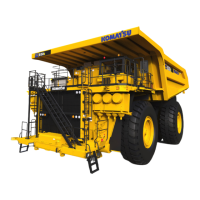AFTER ENGINE HAS STARTED
Any machine which is unsafe and/or not in top operat-
ing condition should not be assigned to an operator for
production use.
1. Become thoroughly familiar with steering and
emergency controls. Test the steering in extreme
right and left directions. If the steering system is
not operating properly, shut engine down imme-
diately. Determine the steering system problem
and have repairs made before resuming opera-
tion.
2. Operate each of the brake circuits at least twice
prior to operating and moving the machine. These
circuits include individual activation of the service
brake and parking brake from the operator’s cab.
a. Activate each circuit individually with the engine
running and with hydraulic circuit fully charged.
b. If any application or release of any brake circuit
does not appear proper or if sluggishness is
apparent on application or release, shut the
engine down and notify maintenance person-
nel. Do not operate machine until brake circuit
in question is fully operational.
3. Check gauges, warning lights and instruments
before moving the machine to insure proper sys-
tem operation and proper gauge functioning. Give
special attention to braking and steering circuit
warning lights. If warning lights come on, shut
down the engine immediately and determine the
cause.
4. Cycle hoist controls and steering several times to
remove trapped air. Complete steering cycles in
both directions to verify steering response,
smoothness and reliability. Check seals and lines
for leaks.
5. When satisfied that all discrepancies have been
corrected, the vehicle is ready for a road test. This
test should be done only by a capable and expe-
rienced operator and should be accomplished in
a large open area where plenty of maneuvering
room is available. Some of the road test items
which should be covered will include:
• Repeated test of braking efficiency at progres-
sively higher speeds. Start at slow speeds.
Don’t take chances with higher speeds until the
machine is determined to be completely safe.
6. When all tests and checks have been made and
the vehicle is ready for work, it should be visually
rechecked and fully serviced according to Section
"P", Lubrication and Service.
A few of the conditions (others may be found) which
might be encountered after a machine has been ex-
posed to the elements for a long period would include:
• Increased corrosion and fungus growth on elec-
trical components in humid/tropical areas.
• Accelerated rust formation in humid climates.
• Increased sand and dust infiltration in windy, dry
dusty areas. (These conditions can approach
sand blasting effects.)
• Deterioration of rubber products in extreme cold
areas. Cables, hoses, O- rings, seals and tires may
become weather checked and brittle.
• Animal or bird’s nests in unsealed openings.
A07003 Storage Procedures A7-9

